Coglio to Alpe Spluga, Switzerland
We got up at 6am. I slept on a mattress on the floor in the living room of Tanja’s apartment. Quentin and Emma slept on the dining room floor. They had arrived the night before. Emma came straight from New Zealand via Tokyo and was jetlagged but excited and ready to go. Quentin had flown in from Estonia and was pretty much in the right time zone.
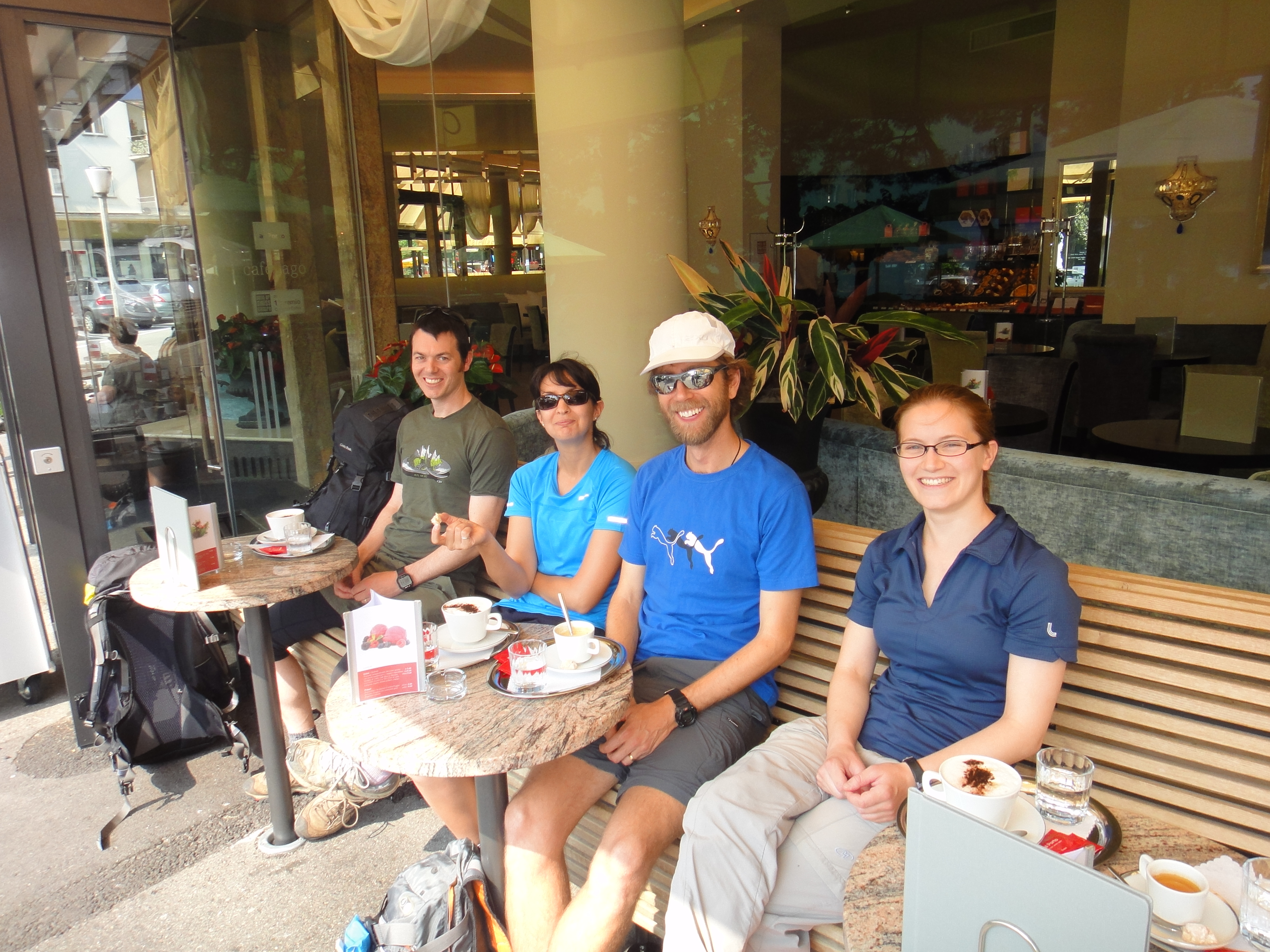
We met Helen, the dynamo Canadian, and fifth member of the team, at the main train station in Zurich and all got on the train just after 7am. We were scheduled for a 3hr journey via two trains to arrive in the Swiss-Italian town of Locarno just after 10am. As it happened our first train was slow and we missed the connection, putting us off schedule.
At Locarno we had some time to spare waiting for the final bus ride up the Maggia valley to the trailhead. So we found a cafe on the lakeshore, drank cappuccinos in the sun, and marveled at the palm trees, luxuriant plants and Italian language that make this part of Switzerland so distinct from the northern cities. I had a Gelato to prime me for the work ahead. The bus took another half an hour to get to the little village of Coglio in the Maggia valley, where after a few minutes of investigation we found the beginning of the trail, and started our ascent about midday. It was a very late start for a long day’s hike.
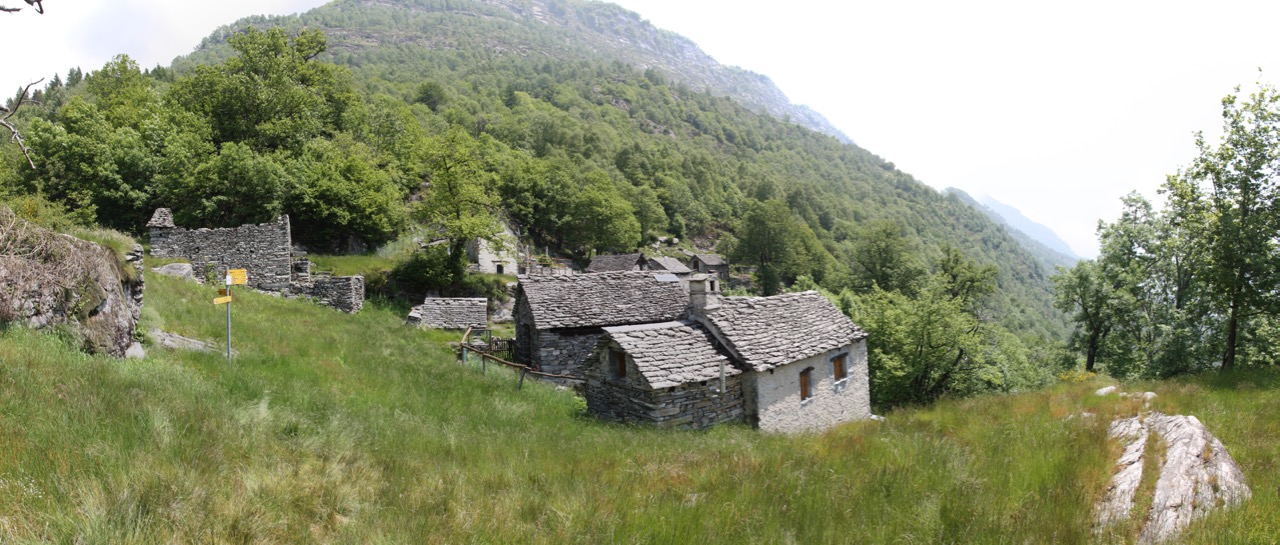
The planned route would take us from 350m above sea level at the floor of the Maggia valley over a mountain pass at 2050m and then across and down to the hut (Alpe Spluga) at 1838m. Since we had started late, the pace was quite quick early on and I reached Spin, our first landmark (a group of largely abandoned stone houses that probably once made up a farming hamlet) at 893m in about 45 minutes. Abandoned stone houses formerly used by high mountain farmers would turn out to be a repeating theme throughout the two days of hiking. The Maggia region had been first settled around 13th century and the historical population of the valley had hovered between a few hundred and few thousand people ever since.
The next stop would be La Valle, a two-hour hike across a steep valley floor and up to about 1268m, where the main climb of the day was to begin. The trees on the lower slopes are deciduous and green and there was a surprising amount of leaf litter underfoot for June. The large drifts of leaf litter were alive with the darting soft-footed movements of hunting spiders. The speckled olive green and dark brown of Podarcis (“wall” lizards) flashed away from their sunning spots on the rocks as we approached. Around a quiet corner at the head of the group I startled a large, almost black, snake, perhaps a meter long that glided sinuously from its sunning spot in the middle of the path into a hole beneath loose boulders to the side of the trail. We later identified it as a non-venomous species widely distributed in this part of Europe. Although I didn’t see any more during our trip, it seemed the perfect habitat for such a predator, with little human disturbance, and a tumbling, food-rich landscape full of nooks, crannies and crevices.
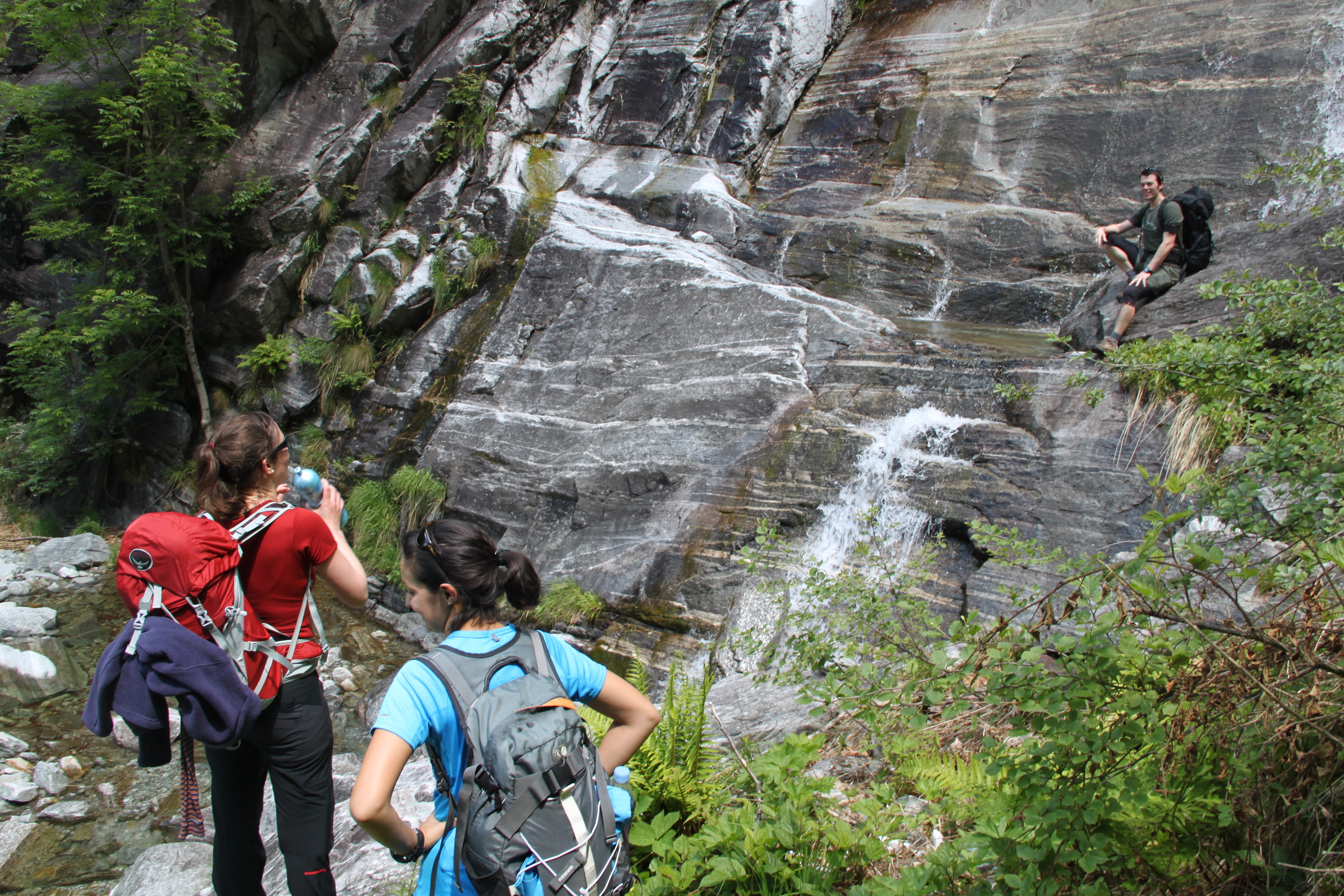
In the first steep descent down to the floor of the side valley we came across an impressive stone staircase, build from careful placement of huge slabs of rock assembled from the surrounds. There had been a number of smaller examples starting at the very beginning of the hike, but this one finally caused me pause for thought about them. I found it hard to imagine the labor, tools and techniques that must have gone into building it. The massiveness of each rock step suggested they could have been here for hundreds of years and none of our party could guess at the age of its construction. It wended down the side of the rocky stream like it had been grown directly from the ground by the magic of Merlin. Certainly not even the wealth of Switzerland would spend money on such organically beautiful engineering in out-of-the-way wilderness in modern times. This path had once served an important role in the livelihood of the locals. We were traveling on a historical trail, and a number of times we passed stone houses that looked also to have grown directly out of the ground, so naturally did they fit into their surroundings. Sadly the roof timbers of many of them had succumb to neglect, and the ruined buildings stood as testament to the fluctuations in prosperity and the diminishing role of the high mountain slopes in the lives of the people of the Maggia region.
At one of the stream crossings a waterfall cascaded down a massive rock face forming a pool in a relief a few meters above the trail where the face of the waterfall rested on another giant protrusion of the mountain’s bones. We had been told that water from the running streams would be good to drink. I climbed up to the pool and cupped my hands to collect some of the cool crystal clear mountain water.
Although it was getting late in the day and we were hungry we decided to press on to La Valle before stopping for lunch. When we arrived at about 3pm we were greeted by a sign informing us that the next stage of our route was dangerous and should be tackled by experienced mountaineers with appropriate equipment only. Tanja assured us that the Italian-speaking officials she had booked the hut with had said nothing of the sort. We resolved to find a place to eat lunch and found the perfect spot just a few minutes along the trail beside a stream fed by a tall delicate waterfall. Another of the denizens of this region is a large species of ant. Black, with iridescent highlights and about 10mm long, these ants build mounded nests out of wood chips and organic detritus and will walk away with any scraps (including large pieces of egg shell) that are inadvertently dropped by feeding hikers. We sat in the sun eating boiled eggs and homemade plum jam on dark German bread. Although it was getting late we didn’t rush to start up again. Ahead of us was the steepest and most grueling part of our journey.

The next section of the hike ascended on the shoulder of the steep valley in an open terrain of grasses, shrubs and rocky outcrops. As we ascended the ever-steepening grade we discussed the need to find the left fork of an expected bifurcation in the trail. We assumed the technical parts of the climb referred to at La Valle must lie on the right fork and not the route we had planned to take to the left. Just after 4pm as the climb reached one of its steepest sections, with Emma forging ahead at the front, a chamois burst from cover and charged down the slope directly at her before veering to its left and disappearing over an apparent bluff. We hurried forward to see where it had gone, only for it to appear again suddenly, running across our path again in the other direction. Quentin took a photo of the fleeing beast before it disappeared for good this time down another vertiginous gulch to our left.
Despite venturing “relentless” as an appropriate adjective for the day’s hiking, Quentin found a second gear and drove ahead to the front of the group stretching up the hill in search of the fork which he duly found. The trees on either side of us thinned out as we ascended, but we did not fully break free of the treeline for another hour of climbing. During this section the cameras disappeared, and my head dropped. My legs started to feel rather leaden and my heart and lungs were laboring more than I was comfortable with. I started slipping back from the front of the group and had to let my younger comrades pass me, watching them slowly disappear ahead up the slope. Our first glimpse of snow came around 5pm as we walked under the shadow of a cliff face that had sheltered a thick swathe of compressed winter snow still a couple of metres thick. We skirted along the melting sides of the mountain’s shrinking winter coat.
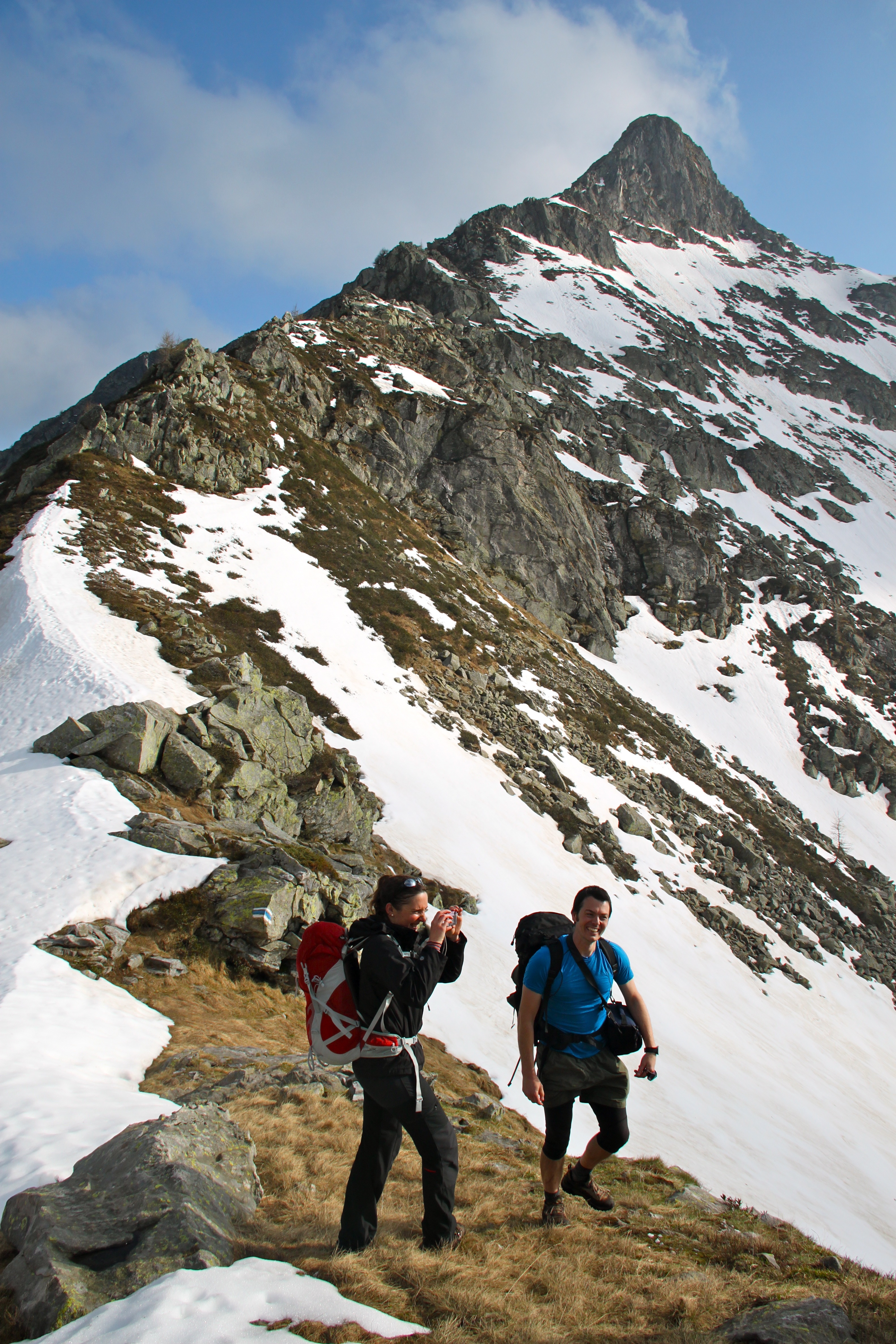
For me it got progressively more challenging to keep up the pace. But the reward for each step was an increasingly alpine vista, as the peaks on each side loomed slowly larger. The steepest part of the descent behind us, there still remained a long final rise, the top of which seemed somehow to recede as we approached it. Just before 6pm we finally crested this rise and the first of the two lakes as well as the saddle itself came into view all at once. The lake was still mostly frozen over, with a ring of water around the edge. The bowl around the lake was still covered with large swathes of snow. Since we lacked crampons, the going became more careful as we picked our way from rock outcrop to outcrop, as far as possible avoiding the expanses of snow.
Finally we reached the saddle and the highest point of our day’s journey. I took a series of photos of the lake we had just passed. There was brief talk about ascending one or both of the peaks to either side of the saddle. They were close, only another 300m vertical, but it was after 6pm and we had just climbed nearly 1800m vertical. When I started to make sounds like I might try one (against my body’s better judgement!), a voice of reason amongst our party suggested we still had some time to go, a fire to start and dinner to make when we arrived at the hut. As it turned out that advice was sound. Despite the disappointment I felt at not tackling one of the peaks, the feeling of elation at reaching the alpine zone and the highest part of our planned route was high, and the group was in a good mood, singing and laughing, as we began picking our way down into the second bowl, skirting around to the right of the even larger field of snow that encircled the second frozen lake.
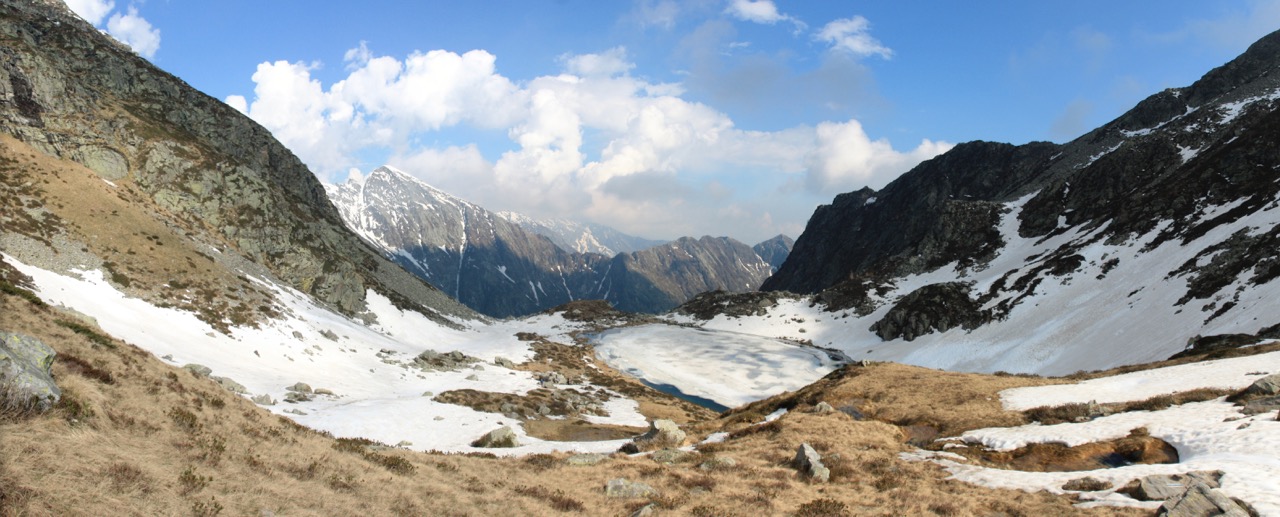
The rocks and boulders on the right shoulder of the second bowl valley were piled large and loose and the going was slow but fun. The marked path was under the snow down to our left, but occasionally a marker was visible on a higher point and we tracked above and parallel the marked path. As we picked and hopped our way over the rocks, I occasionally made forays out onto the snow to see if there were better routes lower down the valley. Most of these required backtracking and once or twice the snow gave way so that I sank down to my waist. It was fun, but also gave pause for thought and eventually we were satisfied to traverse over the loose rocks above the valley floor. It had become clear that this very last section of the hike was the technical portion referred to way down the valley at La Valle. We had thought it would only take an hour, but after an hour of painstaking progress the hut was still nowhere in sight.
We had descended past the lip beyond the second lake and the snow began to thin so that we were able to rejoin the marked trail. It was still a rough and slow-going route traversing across the shoulder of a long valley to another small saddle between one of the side peaks and a tor atop a sheer cliff. From this vantage we could see the cluster of farming buildings that had be refurbished into Alpe Spluga - our destination. But they looked a good 45 minutes or more hike away and the terrain in between was steep and broken and scattered with large loose boulders.
It was ten minutes passed that point, descending down a steep slope strewn with loose boulders that the accident happened. I was tired and my movements weren’t as sharp as they had been, although I was still hopping from boulder to boulder happily enough. But I was starting to drift in my thoughts and as a rounded a large boulder about waist height I stood on some rocks at its base that moved. In a split second the boulder shifted and crashed down on my hip. Its immense weight was a surprise and I had no time to move out of the way before its weight was forcing me down to the ground like domino. In that moment as my leg started to bend unnaturally under the strain I thought it would break and a howl of pain and fear came with the realization.
The split second expanded elastically so that I felt every microsecond. My right shin was being dragged hard across the sharp edge of a stone below the falling boulder. Under the increasing pressure my left leg had slipped over the edge of the rock it had been planted, its shin grazed the full length up to the knee. And then as suddenly as it started it was over. I was flat on the rocks, face down, my right side pressed under the boulder. But I could feel my bones were still intact! With a bit of wriggling I was able to slide my right leg out from under the rock to reveal a neat leg-sized hole that it had come to rest in.
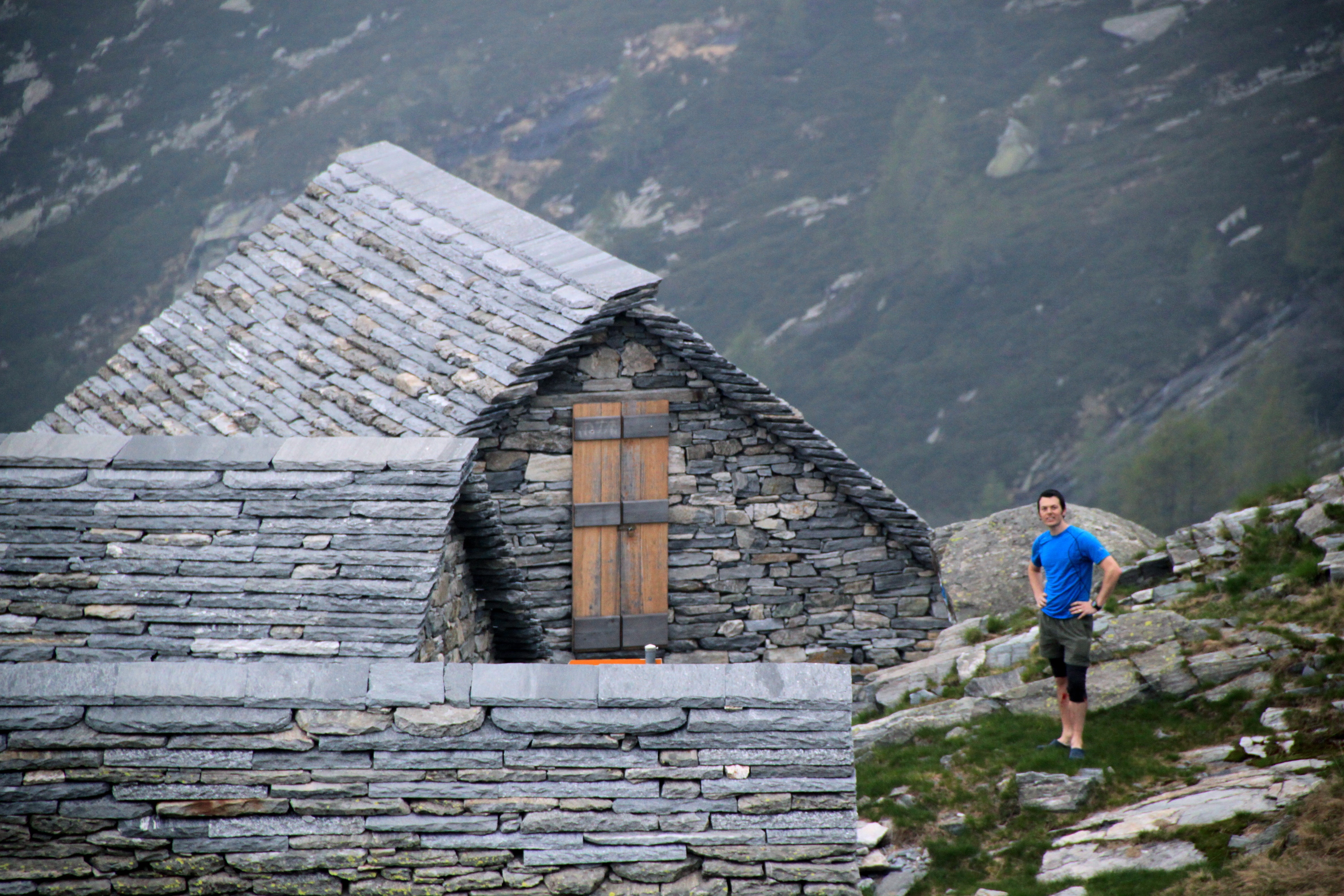
I had been very lucky. My compadres rushed to my side. There was talk of how close I came to needing a helicopter. I pointed to where the top of the rock had broken off on impact with my hip. They looked skeptically on at my wild-eyed rant of anger at the rock, as I tried in vain to lift one side of it, and slapped at its hard implacable surface. Helen suggested she should clean and dress my wounds. I demurred and said I would deal with them at the hut.
The final half an hour was a blur. The adrenaline had kicked in and with blood streaming from my right shin I left the rest of the party behind as I made full haste for the hut. It was partly embarrassment; partly anger; partly an urge to demonstrate I was okay, that drove me forward. I made the hut about ten minutes before the next member of the team.
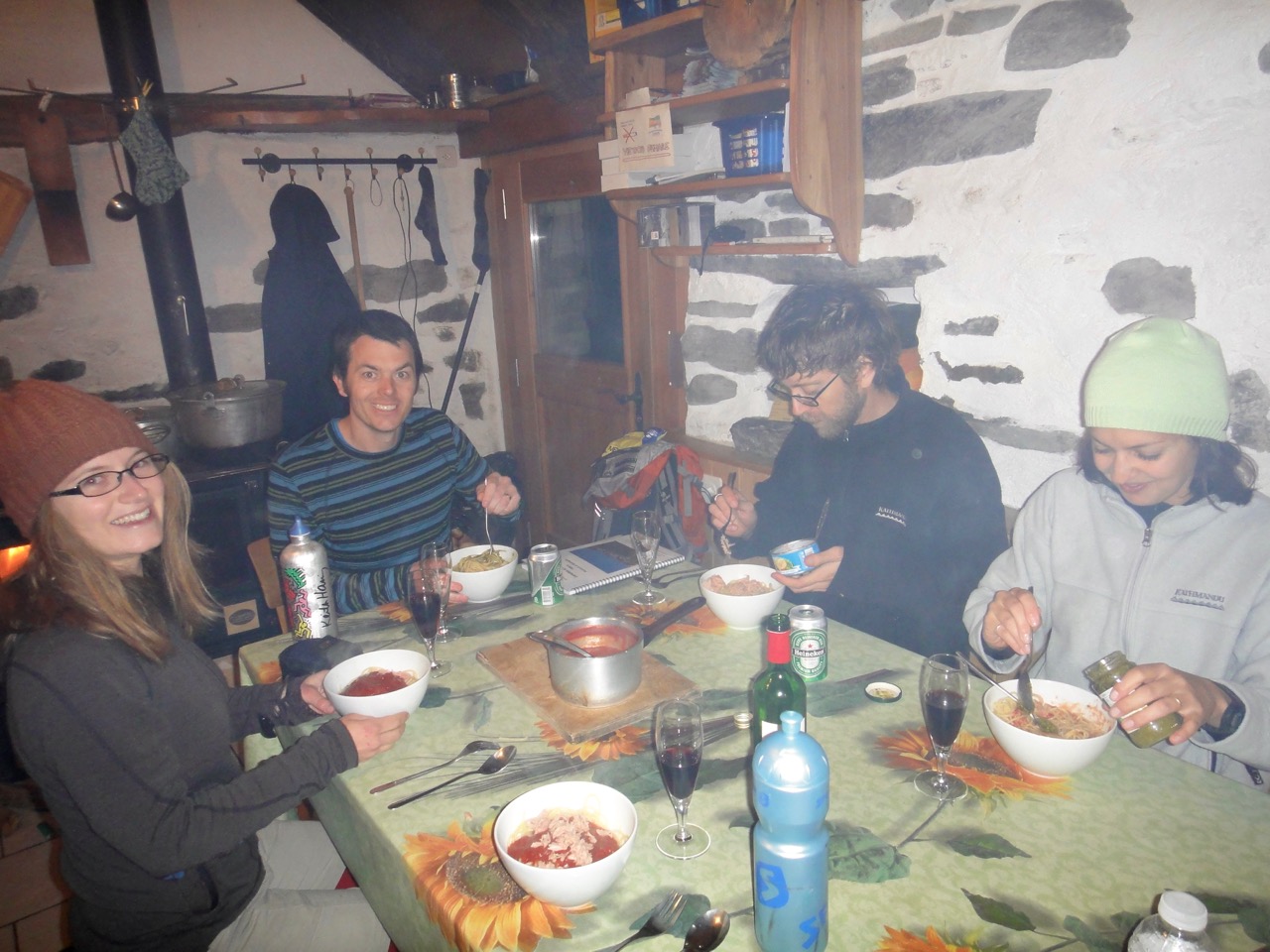
The day’s adventure was over. The hut had wine, food and warmth. We succored of them all. I chopped some wood and started a fire while dinner was being made. A sense of achievement and satisfaction and tiredness pervaded the late evening dinner of spaghetti, tuna and red wine. Simple things are wondrous after a day in the mountains. Spending time with friends in the wild corners of the world. Is there anything better?